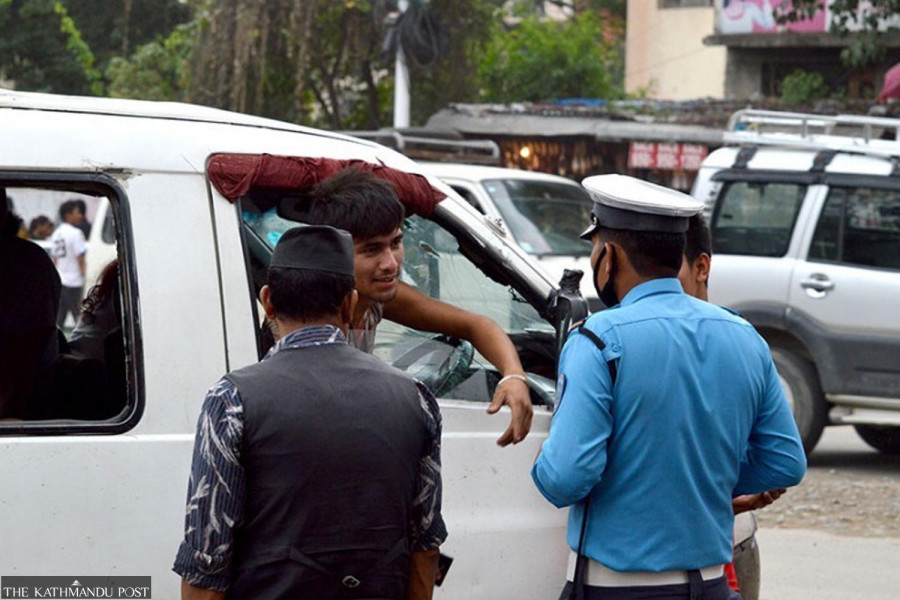Valley
After ‘MaPaSe’, police now launch ‘GaPaSe’ drive
In the past month, police booked 15 persons, including a US citizen, for driving under the influence of drugs.
Anup Ojha
‘MaPaSe’ checking has been a highly successful anti-drink driving initiative of the traffic police in Kathmandu Valley since 2011. Now, the police want to nab even those riding or driving under the influence of banned substances. As most of those being apprehended have been found using marijuana (ganja), the new anti-drug initiative is being informally labelled GaPaSe, which is short for ‘Ganja Padartha Sewan’ (marijuana consumption).
On Saturday, seven drivers, including a US citizen, were caught at a traffic checkpoint at Jagati, Bhaktapur’s southern border, for driving under the influence of drugs.
According to the Traffic Police Circle in Jagati, among those booked, five were motorcyclists, one was a scooter rider and one a cabbie.
Over the past month, the traffic police has issued tickets to an additional eight drivers for driving after taking banned substances.
The Valley traffic police has been conducting its new drive with technical support from the Nepal Police Hospital and the Narcotics Control Bureau, Koteshwar. Along with the inspection team, they also have a lab technician who tests urine with THC rapid urine test (monoclonal antibody to selectively detect elevated levels of substance in urine).
“First, those intercepted at Jagate denied having consumed any drugs,” said Bishal Singh, an inspector, who has been assigned to the field from the traffic headquarters, Baggikhana.
He said the traffic police and other volunteers in the field first talk to drivers by stopping their vehicles and examining their overall behaviour. “When we find their behaviour suspicious, we prolong the interview by taking them to a separate place, and if we feel our suspicions were warranted, we make them undergo a urine test with THC kits,” said Singh.
He said the report comes within two minutes. It confirms whether the person in question has taken a banned substance, even though the test does not pinpoint the substance in question.
“It works like a pregnancy kit, and we get prompt reports,” said Singh.
The Kathmandu Valley Traffic Police Office had announced the start of the new drive from September 25 last year, but it started rigorous checks only last month. Until now, 15 drivers have been booked for driving under the influence of drugs, especially marijuana, according to officials.
“Most of the booked people said they only used marijuana,” said Singh.
Nepal criminalised the sale, cultivation and consumption of marijuana after the introduction of Cannabis and Narcotics Drug Control Act 1976.
Deputy Inspector General (DIG) Mira Chaudhari, who is also the chief of the Valley Traffic, said once a person tests positive for substance use, the person is handed over to the Nepal Police for further investigation.
“We launched this drive because after we made MaPaSe stringent, people started complaining that although we had nearly rooted out drink-drinking, we were being lenient against those who drive under the influence of drugs,” said Chaudhari.
“Our goal is road safety. Driving under the influence of alcohol or any kind of other drugs is strictly prohibited,” said the traffic head.
To be more specific in categorising drugs intake, Chaudhari said the traffic police is in the process of buying Sotoxa. It’s a device that resembles a breathalyser, but instead of testing for traces of alcohol, the device uses an oral fluid swab to detect the presence of drugs such as cocaine, methamphetamine, opiates, and cannabis.
“We are in the process of purchasing it, and this will make our checking even more efficient,” said Chaudhari.
Rajendra Prasad Bhatta, spokesperson at Valley Traffic Police Office said the recently booked people were mainly two-wheeler riders, drivers of public vehicles and truck drivers coming from outside the Valley.
He said after the traffic police took stringent action on drink driving, many riders and drivers had switched over to other kinds of drugs, especially marijuana.
Since the anti-drink drive campaign began in 2011, 404,337 people have been booked for driving under the influence. In the current fiscal year, a total of 29,597 people have been booked, while in the last fiscal year, 33,590 people were booked—the highest in four years.
Bhatta said earlier, even though the traffic police tried to book drivers who were found driving under the influence of drugs, it could not. “We didn’t have the technical manpower and kits,” said Bhatta.
But now, he said, the traffic police are extending their anti-drug drive to other areas of the Valley such as in Nagdhunga, Satdobato and Balaju.
“Last Saturday we checked 30 drivers. Among them, we found seven drug users, which is a lot,” said Bhatta.




 8.12°C Kathmandu
8.12°C Kathmandu.jpg)











